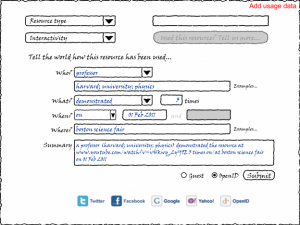User engagement, both online and offline, is an important process for any project delivering successful web-based resources.
Web usability is arguably part of that process, and we were keen to expose projects within the current JISC Content programme to the principles of user centred design early on in the planning of their online resources.
Many projects recently attended a Web usability workshop run by Stuart Church, from pureusability, and blogged about the range of activities they’ve set up for defining their key users, gathering information on users’ needs, and seeking users’ input into the initial mock ups of their web sites.
All projects’ blogs can be found on the JISC Content porgramme’s Netvibes web pages.
My top picks are:
– ENGrich (clustering visual resources on engeneering) posted some initial wireframes displaying not only how their search results pages might look like but also how they might make use of paradata (data from users on how resources are being used) in order to provide added value and context to the resources surfaced through the search.
– Before attempting wireframes, the OVAM (Online Veterinary Anatomical Museum)
project used a visual mind map to represent how the resources aggregated by the virtual museum might be arranged. One can see different routes into the content according to type of user, media type of resource, species and systems.
– In the post First designs and focus group, Manuscripts Online
gives a sneak preview of different home page layouts the team showed to a focus group of users. There’s also a link to documentation on Website design and user testing that might be useful to other projects as well about web design brief, Web2 functionalities and focus group report.
– OBL4HE (Object Based Learning for Higher Education) has conducted some preliminary research on students’ use of online resources and has published their report here – and found that above all online resources need to be
clearly relevant to students’ course tasks and fulfil a need not already met offline



One reply on “How JISC Content projects are tackling Web usability”
I found the most valuable item from the workshop was that it concentrated my mind onto getting in closer contact with the proposed users of our digital microscope – particularly biomedical scientists (MK Hospital) and A-level students (local schools). Not only did they offer insights into what would be most useful for their group, but they offered to loan material for imaging, when we did not have it in the collections of ourselves or our project partners.
I think that an hour spent with someone who can give detailed insight on what they use is more useful than web-surveys.